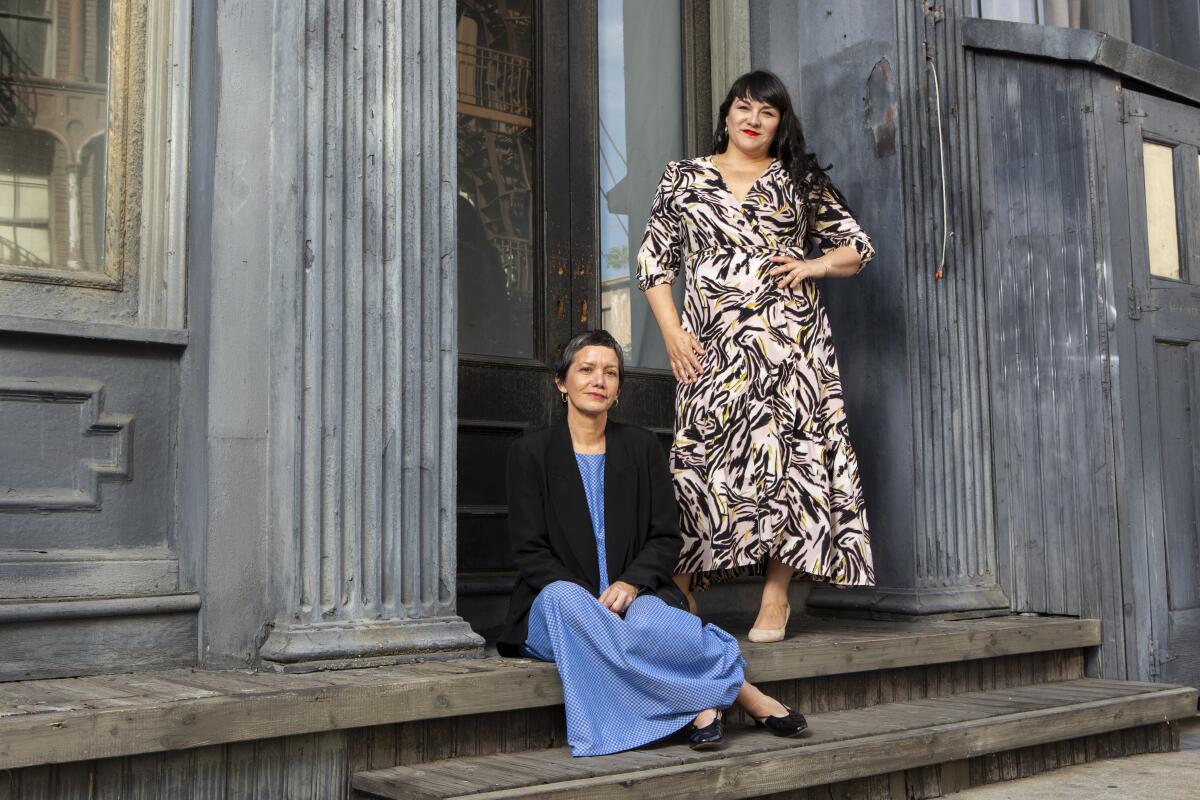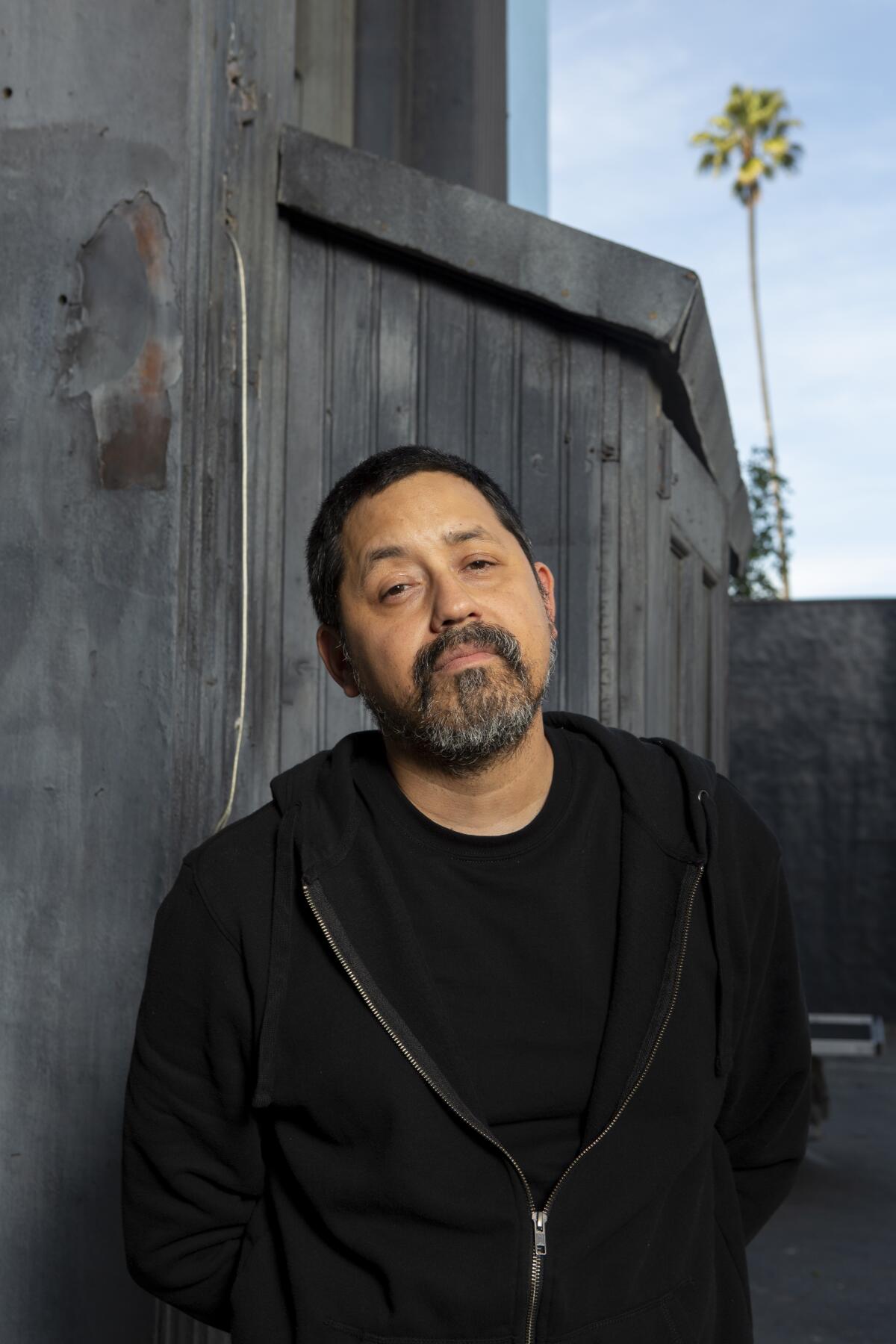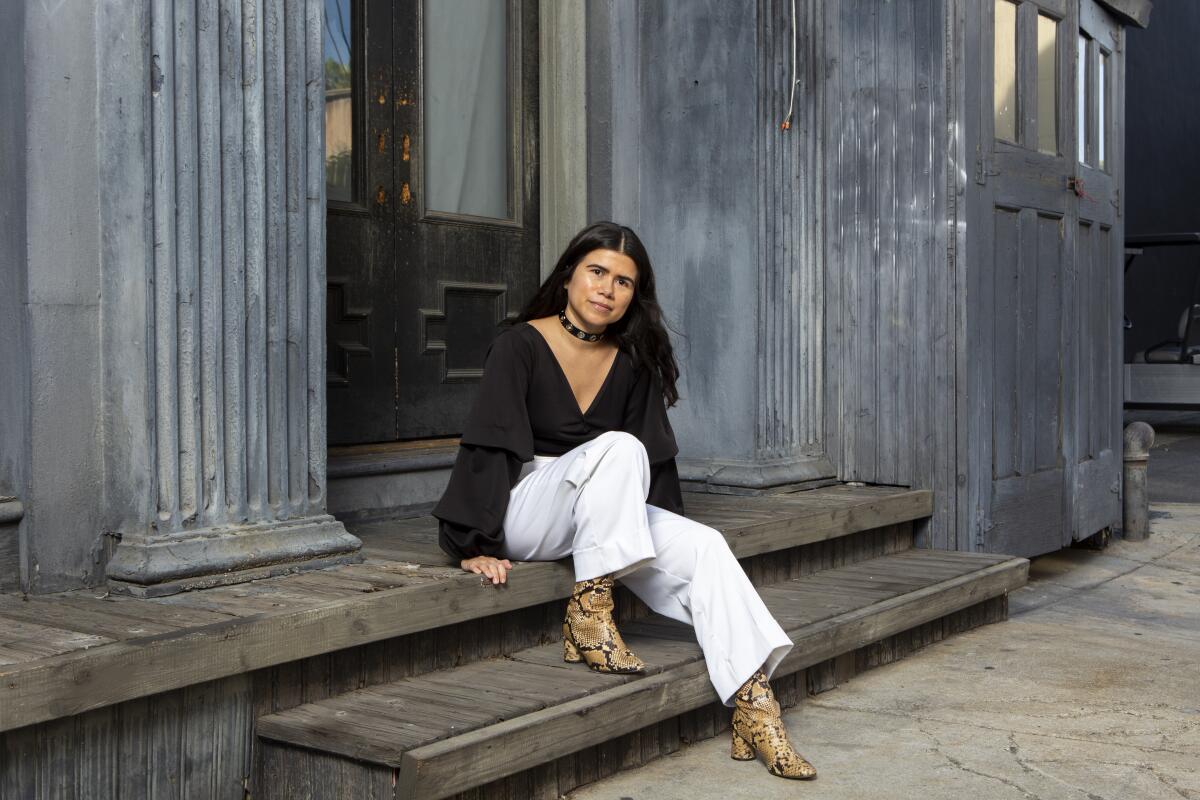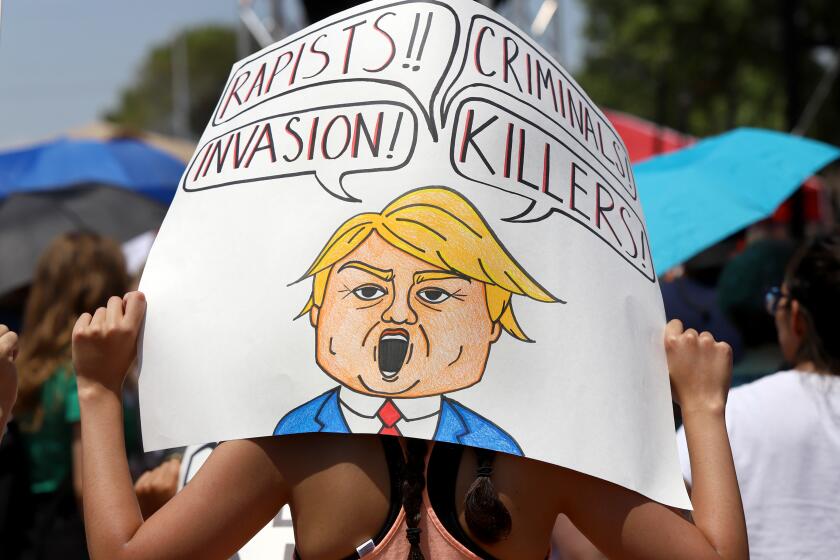How Frieze Projects aims to broaden — and subvert — the Hollywood story

- Share via
The international art fair Frieze Los Angeles is set to touch down on the Paramount Pictures backlot on Valentine’s Day in a veritable storm of art dealing and air kissing. To prepare for this splashy event, Vincent Ramos has been holing up in the studio’s archive.
The Los Angeles artist has a long-running interest in archives: existing ones from official documents and photographs, along with the ones he builds out of pop culture ephemera scavenged from family, friends and eBay. This includes knickknacks, film posters, snapshots and domestic objects that in some way depict Mexican culture.
For the record:
4:58 p.m. Feb. 7, 2020An earlier version of this story reported that Vincent Ramos’ installation would draw from the Paramount Studios archive. While the work will touch on the films he researched in the archive, it will not feature physical objects drawn from the archive. The text has been updated to reflect this change.
“The Frito Bandito is as relevant as images of the Chicano Moratorium to me,” he says, referring to the anti-Vietnam War protest that resulted in the deaths of four people in 1970, including Los Angeles Times columnist Ruben Salazar. “It’s important to show people what existed within the same time frame.”
Ramos assembles these objects into methodical, multilayered installations that occupy vitrines and walls and juxtapose the ways in which Mexicans and Chicanos have been historically depicted in the news and in fiction. To these works, he adds his own drawings, which toy with these symbols of representation.
“It’s reality versus fiction,” he says.

Ramos’ newest installation will center on cinema, drawing from discoveries he made in the Paramount archive and examining the ways in which the film industry portrayed Mexicans over the 20th century, a subject he explored during a Hammer Museum residency in 2011 and 2012. “Wolf Songs for the Dead,” as the new piece is titled, is a nod to Paramount’s 1929 silent film “Wolf Song,” a romance that featured Gary Cooper as a strapping adventurer opposite “Mexican spitfire” Lupe Velez, who spends key scenes decked out in a giant comb and mantilla. (It was a time when the culture at large frequently used signifiers from Spain to evoke the Mexican.)
The piece is set to go on view at the movie studio as part of Frieze Projects, the curated portion of the art fair that is staged in Paramount’s New York City-style backlot. It is a work that will evoke the histories of the studio made famous by Cecil B. DeMille. But it will subvert them too.
That is the aim of the exhibition’s co-curators, Rita Gonzalez, head of contemporary art at the Los Angeles County Museum of Art, and Pilar Tompkins Rivas, who directs the Vincent Price Art Museum. Both have approached their turn with Frieze Projects as not just an opportunity to showcase contemporary art in an appealing location but also as a way to engage a site that has been critical to inserting narratives about people and places into the popular culture.
“There is a terrific allure to Paramount,” Gonzalez says. “But I was also interested in selecting some artists who might have something to say beyond just thinking of it as a backdrop. ... There is a lot going on in terms of discussions of equity and representation with #OscarsSoWhite and #MeToo and Time’s Up. Going into 2020, we didn’t simply want to go back to the backlot and be purely celebratory.”
The show will feature 16 artist interventions that contend with issues of representation in all its guises. This includes pieces that explore the nature of Hollywood stereotypes and the ways in which the entertainment industry fashions perception, along with other pieces that dwell on the nature of artifice.
There is a terrific allure to Paramount. But I was also interested in selecting some artists who might have something to say beyond just thinking of it as a backdrop.
— Rita Gonzalez, curator
As part of this, the curators have commissioned artists to engage the histories that Hollywood frequently overlooks.
“You have this kind of invisibility of certain communities,” says Tompkins Rivas, “thinking about the problematics of the invisibility of the Latino community at a national level.
“It’s always been there, but when we started working on the project, the shooting in El Paso had happened.”
She is referring to a mass shooting at a Walmart in El Paso in August, in which the killer deliberately targeted Latinos — an act that made the invisibility more acute. Latinos are widely underrepresented in Hollywood films, and when they are depicted, it is most frequently as poor, isolated or criminal, according to a report published by the USC Annenberg Inclusion Initiative, along with the National Assn. of Latino Independent Producers and Wise Entertainment, in 2018.
This does little to counter political narratives that frequently depict Latin American immigrants as “invaders.” Says Tompkins Rivas: “All of these issues are intertwined.”
President Trump calls Latinos “invaders.” Culture could offer a counter narrative—yet it does not.
Hence, tapping Ramos to pick through Hollywood history. The curators have also commissioned a large-scale installation by artist Gabriella Sanchez titled “Hommes, Homes, Homes,” inspired by a similar piece she made last year, that will greet visitors as they enter the backlot.
Sanchez, who grew up in Pasadena, is known for creating paintings that explore the shifting meaning of words and images based on the ways in which they are represented. For example, rendering the word “homes” in Helvetica and Old English fonts — the former indicating, perhaps, a house; the latter, evoking Chicano slang for homeboy.

“You have these multiple meanings that all coexist and come with their own context,” Sanchez says. “Having to address what we often don’t acknowledge — the multiple realities that people live in — I thought it was a poignant time to do that. Especially since it’s on the Paramount lot, which is a representation of New York in the middle of Los Angeles.”
Sanchez, who will also have a solo installation inside the fair courtesy of Charlie James Gallery, has also created directional signage for Frieze that plays with some of these same concepts: mixing and remixing words and fonts so that a simple sign reading “THIS WAY” becomes upon closer inspection “THIS — is not the only — WAY.”
“I like bringing out the psychology of the rules and contexts we use to communicate,” she says, “but that we don’t lay out and think about.”
Other, more literal forms of representation will also be explored.
Los Angeles artist Sayre Gomez will have a sculpture inspired by the cellphone towers that pose as palm trees, while Mungo Thomson will present bronze sculptures that reference the ubiquitous Amazon box.
Gary Simmons, who three years ago created a monumental installation for the California African American Museum that highlighted forgotten African American films, will present “Backdrop Project,” a 1993 work that reveals the ways in which a painted backdrop can conjure worlds.
For that piece, he created paintings that bear images from black vernacular culture, such as a kente cloth pattern bearing the logo Nubian Queen, and invited the public to pose before them for Polaroid portraits — a work that was Instagram-prescient.
“It’s creating this space of self-representation or self-fashioning,” Gonzalez says. “If you walk into a gallery and you feel like an outsider or interloper, this allowed you to meld into the backdrop.”
One of the show’s aims is also to highlight L.A.’s cultural links to Latin America.
“Rita and I both come at this from hemispheric dialogues,” says Tompkins Rivas. “We have collaborated in the past on PST: LA/LA” — the Getty-funded Pacific Standard Time shows devoted to Latin America. “We’ve done research trips all over Latin America. So that’s been an ongoing conversation for quite some time.”
In addition to artists from across the U.S., Frieze Projects will feature installations by Mexican artists Tania Candiani and Mario García Torres, as well as Jonathas de Andrade, who hails from Brazil.
De Andrade is presenting a piece that could not be more apropos for an art fair: “Voyerístico,” a video from 2018, in which he asked people on the streets of Brazilian cities to let him film the contents of their wallets.
Gonzalez notes that an art fair is, after all, a place “where there is this power dynamic of haves and have nots, people who are there for the exchange of materials and goods.”
In other words: money.
But it is ultimately Ramos’ work that will dig most directly into the history of Paramount — and by extension, a history of the ways in which Mexicans have been rendered (or not) in U.S. cinema.
The artist says he has found that Mexicans were most frequently depicted in the films of the 1930s, ’40s and ’50s. “There was a period during the ’30s and ’40s with Lupe Velez, where Mexicans were leading men and leading women,” Ramos says. “You had Dolores del Río, Leo Carrillo, Ricardo Montalbán, Anthony Quinn, Gilbert Roland.”
But a good deal of the Mexican presence from that era was also due to the popularity of westerns, with their prevalence of thieving, violent bandidos. That representation began to drop off by the 1960s and ’70s.
“You saw more cop shows,” Ramos says. But “in those instances, if there was a Mexican or a Chicano, it was a criminal. So it was as if they just updated the stereotype. It’s hardly ever the kind of leading man role.”
That doesn’t mean there haven’t been moments of accomplishment.
There is the story of Francisco “Chico” Day, who served as an assistant director on DeMille’s 1956 epic “The Ten Commandments” and who was the first Mexican American to become a member of the Directors Guild of America. (No images of him were available in the Paramount files, but Ramos was able to locate one on eBay of Day, who was the brother of actor Roland.)
And there were the myriad performances given by actors who were simply doing their best.
Ramos points to the 1961 western “One-Eyed Jacks,” directed by Marlon Brando. Brando and Karl Malden play bank robbers; Mexican actress Katy Jurado plays Malden’s wife.
Mexicans in lead roles were often played by white actors wearing a heavy coat of brown makeup. But “Brando was good at not utilizing the brown-face thing,” Ramos says, “using these actors that were either Mexican or of Mexican descent.”
“The performances are very nuanced and pretty complex,” he adds. “There’s this scene with Katy Jurado with her daughter, played by Pina Pellicer, and they’re speaking in Spanish and there are no subtitles, so you rely on their body movements, and it’s really beautiful.”
In other words, actors rendering characters of flesh and blood — making them visible. All they needed was an opportunity.
Frieze Projects
Where: Paramount Studios, 5555 Melrose Ave., Hollywood
Admission: $25-$60 for Frieze Projects and programs; $125-$500 for the broader Frieze Los Angeles fair, talks and other programs and Frieze Projects
Info: (844) 584-0653, frieze.com
More to Read
The biggest entertainment stories
Get our big stories about Hollywood, film, television, music, arts, culture and more right in your inbox as soon as they publish.
You may occasionally receive promotional content from the Los Angeles Times.












